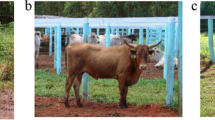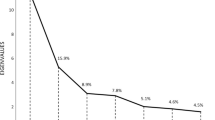Abstract
Carcass performance of 12 fattened male buffalo calves equally grouped by slaughter weights of 300, 350, 400, and 450 kg was evaluated. Six parameters of body measurements such as chest girth, height at withers, body length, body depth, width at pin bones, and diagonal body length were recorded for each calf immediately before slaughter to test their relationships with live body weight, carcass weight (hot and cold) and its components (head, legs, liver, heart, etc.), and eye muscle area at the 10th–13th ribs. Boneless meat and bones formed 36.6 to 39.0% and 9.3 to 11.0% of live weight, respectively. Chest girth had strong correlation with all carcass traits except bone weight and was the best predictor of boneless meat and carcass fat weights (R2 = 0.90, 0.78). The slaughter weight and height at withers and the 10th–13th rib fat weight were the best predictors of hot and cold carcass (R2 ≥ 97.0), carcass bones (R2 = 76%), and hot and cold carcass (R2 = 85.0, 86.5%) weights, respectively.

Similar content being viewed by others
References
Abo El-Makarm H. A.M , 2003. Carcass characteristics and meat quality of camels and buffaloes. Ph.D. Thesis, Cairo University, Egypt.
Afolayan, R.A., Deland, M.P.B., Rutley, D.L., Bottema, C.D.K., Ewers, A.L., Ponzoni, R.W. and Pitchford, W.S., 2002. Prediction of carcass meat, fat and bone yield across diverse cattle genotype using live-animal measurements. The Australian Society of Animal Production,24, 13–16.
Aksoy, A.R., Kirmizibayrak, T. and Saatcü, M., 2006. The effect of age on slaughter and carcass characteristics in male Zavot cattle. Turkish Journal of Veterinary and Animal Sciences, 30, 527–532.
Amsa, 2001a. Grading/classification. in: meat evaluation handbook. USA: American Meat Science Association, USA, 9–11.
Amsa, 2001b. Retail cutevaluation. in: meatevaluation handbook. USA: American Meat Science Association, USA, 12–14.
Bergen, R., Miller, S.P., Wilton, J.W., Crews Jr., D.H. and Mandell, I.B., 2006. Genetic correlations between live yearling bull and steer carcass traits adjusted to different slaughter end points 1. Carcass lean percentage. Journal of Animal Science, 84, 546–557.
Casa, E. and Cundiff, L.V., 2006. Post weaning growth and carcass traits crossbred cattle from Hereford, Angus, Norwegian Red, Swedish Red and White, Friesian, and Wagyu maternal grandsires. Journal of Animal Science, 84, 305–310.
Chashnidel, Y., Pirsaraei, Z.A. and Elahi, M.Y., 2007. Comparison of daily weight gain and fattening characteristics between buffalo and Holstein male calves with different diets. Italian Journal of Animal Science, 6, 1199–1201.
Choat, W.T., Paterson, J.A., Rainey, B.M., King, M.C., Smith, G.C., Belk, K. E. and Lipsey, R.J., 2006. The effects of cattle sex on carcass characteristics and longissimus muscle palatability. Journal of Animal Science, 84, 1820–1826.
Desta, T.T., 2012. Introduction of domestic buffalo (Bubalus bubalis) into Ethiopia would be feasible. Re-newable Agriculture and Food Systems, 27, 305–313.
Dolezal, H.G. and Hilton, G.G., 2010. Beef carcass grading. in: meat grading and selection (13th ed.) USA: Oklahoma State University, USA, 4–25.
FASS (Federation of Animal Science Societies), 2010. Guide for the Care and Use of Agricultural Animals in Research and Teaching. 3rd ed., Champaign, IL.
Greiner, S.P., Rouse, G.H., Wilson, D.E., Cundiff, L.V. and Wheeler, T.L., 2003. Accuracy of predicting weight and percentage of beef carcass retail product using ultrasound and live animal measures. Journal of Animal Science, 81, 466–473.
Hankins, O.G. and Howe, P.E., 1946. Estimation of the composition of beef carcasses and cuts. Technical Bulletin, United States Department of Agriculture - USDA, Washington, D.C., USA. 926, 1–19.
Haryoko, I. and Suparman, P., 2009. Evaluation of carcass production of Po cattle based on heart girth measurement, body condition score and slaughter weight. Animal Production, 11, 28–33.
Holloway, J.W., Savell, J.W., Hamby, P.L., Baker, J.F. and Stouffer, J. R., 1990. Relationships of empty-body composition and fat distribution to live animal and carcass measurements in Bos indicus-Bos taurus crossbred cows. Journal of Animal Science, 68, 1818–1826.
Kandeepan, G., Biswas, S. and Rajkumar, R.S., 2009. Buffalo as a potential food animal. International Journal of Livestock Production, 1, 001–005.
Khasrad and Ningrat, R.W.S., 2010. Improving carcass quality of indigenous cattle of West Sumatera fed local feed resources. Pakistan Journal of Nutrition, 9, 822–826.
Mahmoudzadeh, H., Fazaeli, H., Kordnejad, I. and Mirzaei, H.R., 2007. Response of male buffalo calves to different levels of energy and protein in finishing diets. Pakistan Journal of Biological Sciences, 10, 1398–1405.
Manafiazar, G., Mohsenourazary, A., Afsharihamidi, B. and Mahmoodi, B., 2007. Comparison carcass traits of Azeri buffalo, native and crossbred (native * Holstein) male calves in west Azerbaijan-Iran. Italian Journal of Animal Science, 6, 1167–1170.
Neath, K.E.A.N., Del Barrio, R.M., Lapitan, J.R. and Herrera, L.C., 2007. Difference in tenderness and pH decline between buffalo and beef during post mortem aging. Meat Science,75, 499–505.
Nephawe, K.A., Cundiff, L.V., Dikeman, M.E., Crouse, J.D. and Van Vleck, L.D., 2004. Genetic relationships between sex-specific traits in beef cattle: Mature weight, weight adjusted for body condition score, height and body condition score of cows, and carcass traits of their steer relatives. Journal of Animal Science, 82, 647–653.
NRC (National Research Council), 2001. Nutrient requirements of beef cattle. National Academy Press, Washington, DC.
OlivaÂn, M., Martõnez, A., Garcõa, P., Noval, G. and Osoro, K., 2001. Estimation of the carcass composition of yearling bulls of “Asturiana de los Valles” breed from the dissection of a rib joint. Meat Science, 57, 185–190.
Ong, S.Q., Lee, B.B., Tan, G.P. and Maniam, S., 2017. Capacity of black soldier fly and house fly larvae in treating the wasted rice in Malaysia. Malaysian Journal of Sustainable Agricultural, 1, 08–10.
Qing, L., Youwen, W., Liqin, T., Jing, L., Qiongfen, L., Shuai, T., Siyuan, S., Chengming, D., Wen, L. and Huaming, M., 2018. Effects of age on slaughter performance and meat quality of Binlangjang male buffalo. Saudi Journal of Biological Sciences, 25, 248–252.
Ranjhan, S.K., 2013. Latest concepts in rearing buffaloes for meat production. Buffalo Bulletin, 32, 319–328.
Rodas-González, A., Juàrez, M., Robertson, W.M., Larsen, I.L. and Aalhus J.L., 2013. Characterization of Canadian grade standards and lean yield prediction for cows. Canadian Journal of Animal Science, 93, 99–107.
SAS (Statistical Analysis System User’s Guide), 2004. SAS Institute, Inc., Cary, version 9. North Carolina, USA.
Soeparno., 1992. Ilmu dan teknologi daging. Gajah mada university press. Yogyakarta.
Spanghero, M., Gracco, L., Valusso, R. and Piasentier, E., 2004. In vivo performance, slaughtering traits and meat quality of bovine (Italian Simmental) and buffalo (Italian Mediterranean) bulls. Livestock Production Science, 91, 129–141.
Suryadi., 2003. The effect of slaughter weight on the main pieces and the crumbs of carcass of Brahman cross cattle. The Scientific Magazine of Livestock, 6, 100–104.
Tatum, J.D., Dolezal, H.G., Williams Jr., F.L., Bowling, R.A. and Taylor, R.E., 1986. Effects of feeder-cattle frame size and muscle thickness on subsequent growth and carcass development. II. Absolute growth and associated changes in carcass composition. Journal of Animal Science, 62,121–131.
Tennant, C.J., Spitzer, J.C., Bridges Jr., W.C. and Hampton, J.H., 2002. Weight necessary to change body composition scores in angus cows. Journal of Animal Science, 80, 2031–2035.
USDA (United States Department of Agriculture), 2018. Livestock and products annual 2018; Egyptian beef prices stable, consumption and imports to rise in 2019. GAIN report number: EG-18021, USA.
Yusnayeti., 1986. Hubungan antara luas udamaru dan tebal lemak punggung terhadap persentase karkas sapi. Fakultas Peternakan, Universitas Andalas.
Zorrilla-Ríos, J.M., Lancaster, P.A., Goad, C.L. and Carrasco, D.M., 2013. Applicability of prediction equations for cutability in beef carcasses in Jalisco. Mexico, Revista Avances en Investigación Agropecuaria, 17, 119–134.
Acknowledgments
The authors wish to thank all the staff members of the Feeds and Fattening Unit belonging to Alexandria University, Egypt, for their assistance throughout the work of this study.
Author information
Authors and Affiliations
Corresponding author
Ethics declarations
All applicable international, national, and/or institutional guidelines for the care and use of animals were followed. All procedures performed in studies involving animals were in accordance with the ethical standards of the institution or practice at which the studies were conducted. Also, the study was conducted in a manner that avoided unnecessary discomfort to the animals by the use of proper management.
Conflict of interest
The authors declare that they have no conflict of interest.
Additional information
Publisher’s note
Springer Nature remains neutral with regard to jurisdictional claims in published maps and institutional affiliations.
Rights and permissions
About this article
Cite this article
Rashad, A.M.A., EL-Hedainy, D.K., Mahdy, A.E. et al. Utilization of live body weight, measurements, and eye muscle components to predict carcass performance of fattened Egyptian male buffalo calves. Trop Anim Health Prod 51, 2405–2412 (2019). https://doi.org/10.1007/s11250-019-01950-x
Received:
Accepted:
Published:
Issue Date:
DOI: https://doi.org/10.1007/s11250-019-01950-x




